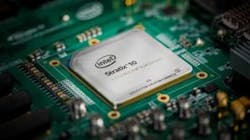The Year in Cloud: Microsoft Invests in ARM, FPGAs and GPUs
For Microsoft, 2017 was a year of major progress in its cloud computing operation, which saw strong growth across both business and consumer portfolios. Microsoft also focused on hardware in a big way, continuing its innovation with FPGAs (Field Programmable Gate Arrays) and GPUs to speed its networking and machine learning services, respectively. In a new wrinkle, Microsoft also gave a major boost to the movement to adopt low-power ARM processors in cloud servers.
The company also continued to be a player in data center real estate. After an epic year of wholesale leasing in 2016, Microsoft signaled that it will likely build its own cloud campus in Silicon Valley, where it bought a land parcel in San Jose.
Read on to stay current on the latest moves from Microsoft in the cloud:
A wall of densely-packed cloud servers in a modular deployment at Microsoft. (Photo: Microsoft)
Jan. 17: Microsoft Deals Drive Blockbuster Year for Data Center Leasing: Microsoft leased as much as 125 megawatts of third-party data center space in 2016, accounting for the top six deals in the wholesale data center market during that year according to a market report. Massive deals by Microsoft drove a 25 percent increase in data center leasing activity from 2015, according to the report, which says 2017 may see a continuation of cloud-driven growth. Read more.
March 13: Microsoft Boosts Hopes that ARM Servers Can Power the Cloud: Microsoft has given a major boost to the nascent market for servers powered by low-energy processors from ARM, which are widely used in mobile devices like iPhones and iPads. At the Open Compute Summit, Microsoft confirmed that it is test-driving ARM cloud servers from Qualcomm and Cavium in its data centers. “The Microsoft endorsement is a defining moment in ARM server history,” said Syed Ali, the President and CEO of Cavium. “We think this will significantly accelerate others accepting these servers. This will start a tsunami effect in the whole ecosystem.” Read more.
March 20: Microsoft, NVIDIA Roll Out Cloud AI Hardware: The leading hyperscale data center players continue to roll out new hardware designs to power machine learning applications. At the Open Compute Summit, Microsoft and NVIDIA unveiled a new hyperscale GPU accelerator for artificial intelligence workloads in the cloud. The HGX-1 harnesses eight NVIDIA Tesla P100 GPUs and high-speed interconnects. Read more.
The Intel Stratix 10 FPGA is a key accelerator for Project Brainwave, Microsoft’s new approach to hardware for artificial intelligence. (Photo: Intel)
Aug. 23: Project Brainwave — Intel FPGAs Accelerate Microsoft’s AI Hardware: The artificial intelligence arms race continues, as the largest tech companies explore new ways to accelerate AI workloads for cloud platforms. Microsoft unveiled Project Brainwave, a deep learning acceleration platform the latest fruits of its collaboration with Intel on FPGA-based computing. Read more.
Oct. 2: Microsoft Buys Land for Data Center Campus in San Jose: Microsoft’s plans mark a departure from several prevailing trends in the Silicon Valley data center market, where most of the action has focused in Santa Clara, and hyperscale players have historically leased space from third-party providers, rather than building their own facilities. Microsoft has bought 65 acres of land in northern San Jose where it plans to build a data center campus, a departure from several prevailing trends in the Silicon Valley data center market. Read more.
To read more on the year in cloud and make sure you stay up to date on Microsoft data center news, see here.
Keep pace with the fact-moving world of data centers and cloud computing by following us on Twitter and Facebook, connecting with Data Center Frontier editor Rich Miller on LinkedIn, and signing up for our weekly newspaper using the form below.



